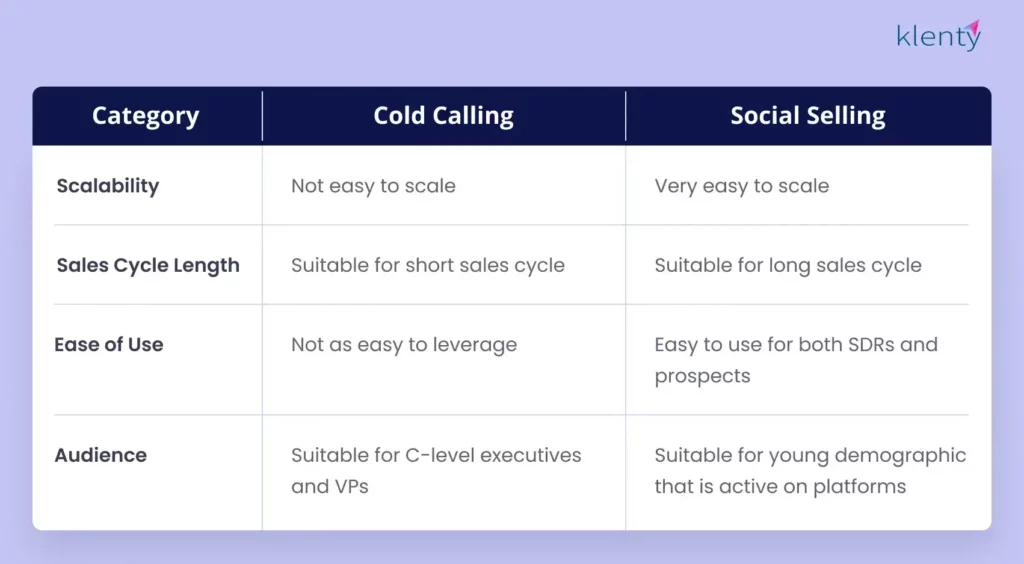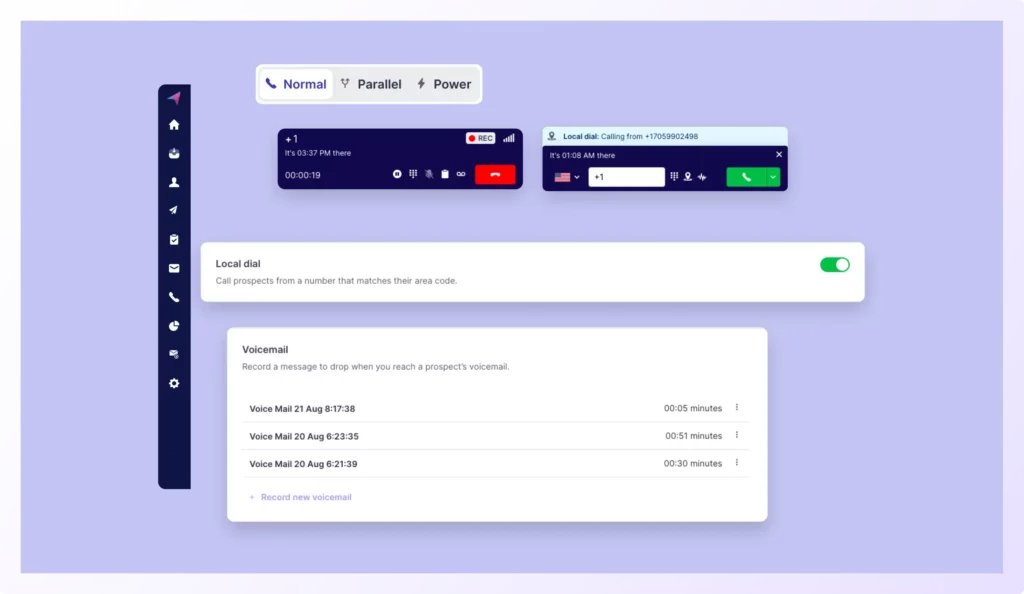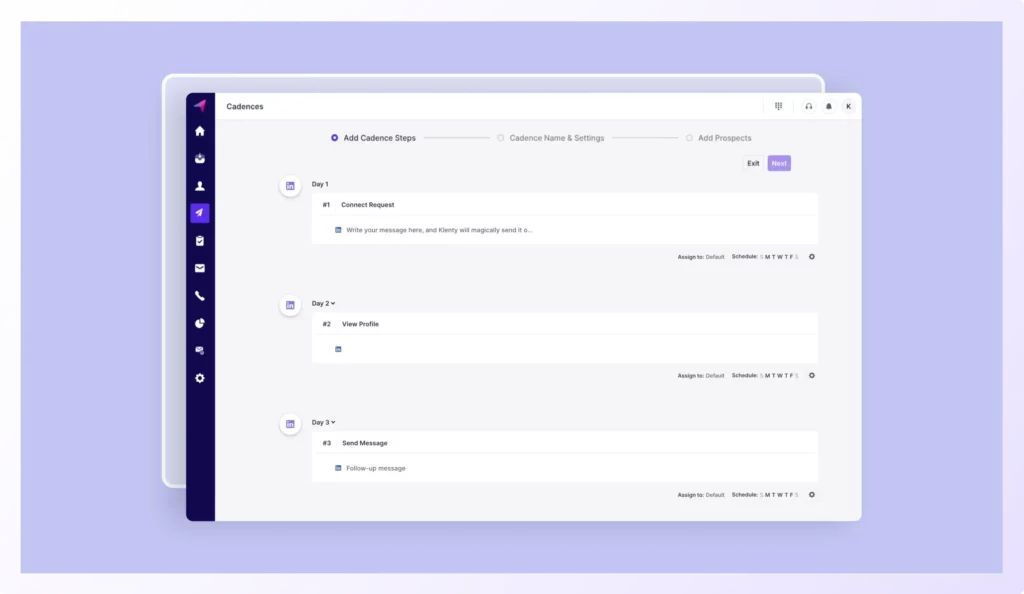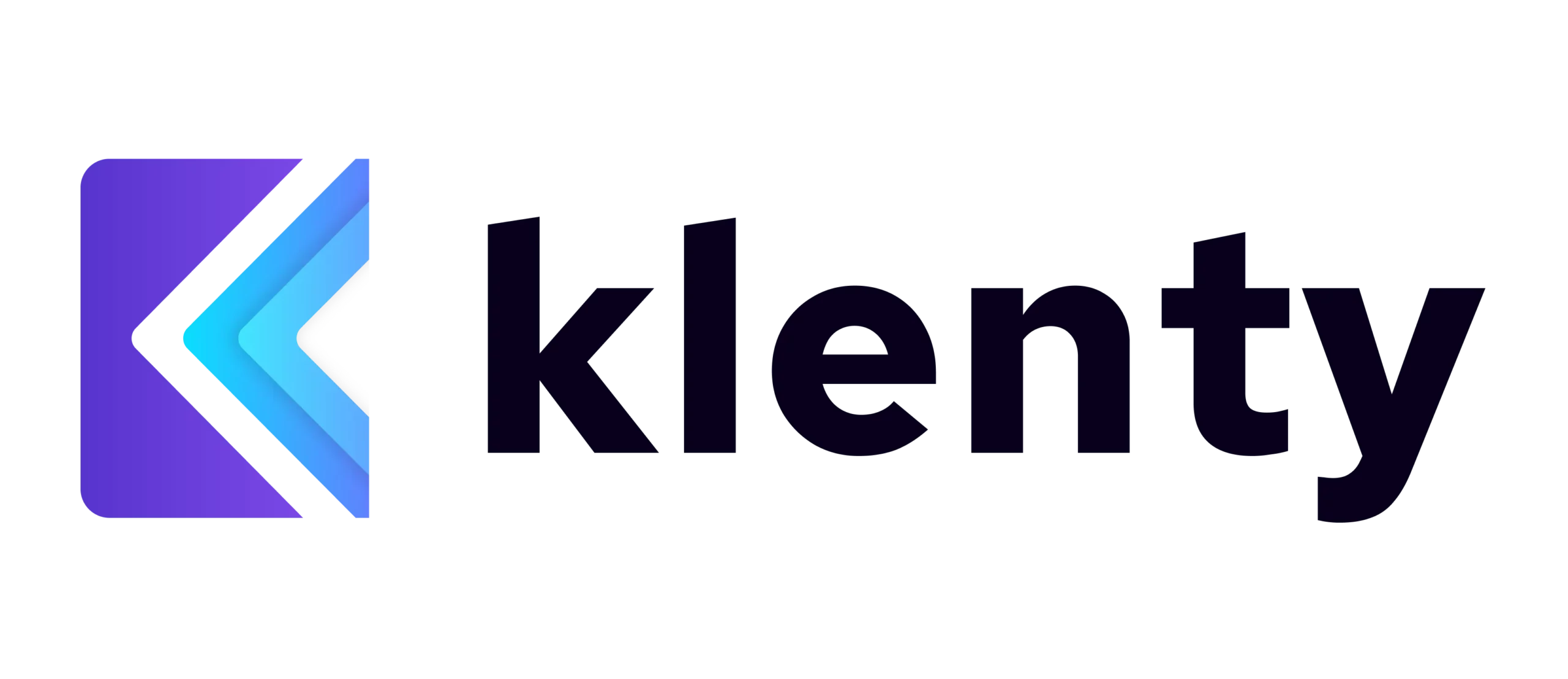As a sales development representative, you know the value of a robust prospecting strategy.
A well-planned, comprehensive one can ensure the success of your sales and revenue figures. And today, the most effective techniques involved in this process include cold calling and social selling.
Both are effective ways to reach prospects. But, when it comes to cold calling vs. social selling, which one do you think is the superior prospecting channel?
In the blog, we’ll dive deep into both of these outreach channels, exploring their pros, cons, and when you should use which to help you ensure your outreach efforts always thrive.
What Is Cold Calling?
Cold calling refers to connecting with prospects who aren’t aware of your product but fit your Ideal Customer Profile (ICP) over the phone.
In other words, cold calling is contacting an individual or business with whom you have no past relationship with an aim to build their interest in your offering and ultimately convert them into paying customers. All via the good ol’ phone.
Pros & Cons of Cold Calling
Pros of Cold Calling
- Get Immediate Feedback
With cold calling, SDRs get instant feedback and insight into how their prospects are receiving the pitch. During your call, you can ask them what they think about your product, their objections, reservations, etc. Based on this, you can tweak your pitch accordingly to tackle their specific pain points head-on.
It is because of its immediacy that Nikita Solberg, a seasoned SDR, prefers cold calling. They say, “One thing I like about it is because it's very quick. That’s why I spend so much time cold calling because it is so easy to get that yes or no.”
- Learn More About the Prospect Directly
In all other outreach techniques, you need to rely heavily on indirect sources such as their company website, social media activity, published articles, etc., to learn about your prospect. It's never from the horse's mouth. But in cold calling, since you’re talking directly to your prospect, you learn about their business and how best to solve their problem directly from them.
A crisp conversation with targeted questions can give you insight into how you can create a prize-winning pitch that knocks their socks off.
- Helps Build Better Rapport Through Human Touch
Cold emails and LinkedIn messages are easily ignorable—they’re just words on a screen. But, cold calling allows SDRs to add a human touch to their prospecting efforts. Calling has greater immediacy, emotional intelligence, and persuasive ability than any other outreach channels.
So, taking the time to call your prospect and talk to them directly instead of from behind a screen helps you nurture the relationship and build stronger rapport with them. Real-time conversations help your prospects feel less like a name on a list and make them feel valued and seen.
Alastair Chamberlin, an SDR manger, has this to say about why cold calling helps in rapport building: “I think if you're conversational, and you have a genuine conversation with someone about anything, I think you can build rapport through that.”
Cons of Cold Calling
- Relatively Low Success Rate
Cold calling has an average conversion rate of 2%. This is because your prospect isn’t actively researching your offering or even looking for a solution in your space. As a result, your calls might be thwarted and rejected.
Further, since this technique is disruptive in nature and disturbs your prospect’s schedule, you’ll often face complete disinterest as well.
- Some Prospects Find It Intrusive
This sales outreach method can be intrusive for your prospects as they might not have shown any interest in your offering to warrant this interruption. Not only that, it could also leave a bad taste in their mouth and turn them completely against your solution.
They could associate negatively with your product and reduce the chances of further contact as well.
- Can Be Resource-Intensive
Cold calling can demand a lot in terms of time, human resource and software investment to help manage your outreach effectively. And the ROI can be lower than desired.
For instance, let’s say your SDR makes 200 cold calls in a day, which takes about 6 hours. Out of these 200 calls, only 20 might get answered. Further, your sales rep will probably have meaningful conversations with 5 or 10 prospects. And by the end of it, they’ll be able to book only 1-2 meetings. Sounds frustrating, but that’s the ground reality.
So, you need reps to make more dials, and you need more reps to place more cold calls to hit your revenue goals. This means significantly more investment in software, which can strain your overhead costs.
When To Use Cold Calling?
Cold calling has its pros and cons like all sales techniques. But even with the disadvantages mentioned above, this sales outreach technique is not to be taken lightly. Here are some scenarios where cold calling packs a strong punch.
- You Want to Shorten Your Sales Cycles
Cold calling allows you to connect directly with your prospect to understand their job, pain points, priorities, and goals. Gaining this information straight from your prospect helps you build a rapport with them and nurture a relationship of trust.
And when you know how they think, what they want, and what’s holding them back, you can approach their account like a pro and nudge them down the sales pipeline smoothly.
- You’re Reaching Out To C-level Executives
Contrary to the general notion, cold calling is quite popular among C-level executives and VP buyers. In fact, research by RAIN Group finds that a whopping 57% of this prospect demographic prefers their phones to ping rather than emails.
So, if your prospects belong to this group, cold calling is your best shot.
- You’re Targeting Industries Who Prefer Calls
Lastly, cold calling is best for prospects in industries that prefer to be contacted via phone. According to Hiya’s State of the Call report, healthcare, auto service providers, insurance, and banking and financial transactions are some industries where the phone is the most preferred choice for communication.
In such a case, contacting prospects via any other medium would probably be something you could add to your 3 a.m thoughts—Why did you do that again?
What Is Social Selling?
Social selling is a sales technique wherein you leverage a prospect’s social media presence to connect with them, engage them, and ultimately convert them. It’s a great way to build brand awareness, inform prospects about your offering, and further brand affinity.
Social selling means using platforms like LinkedIn, Twitter, Instagram and Facebook to identify prospects, share targeted content, build credibility and provide value to them. Doing this helps SDRs build rapport and trust with their prospects, making them more likely to convert into buying customers.
Pros & Cons of Social Selling
Pros of Social Selling
- Ease Of Use for Buyers and Sellers
Social selling gives SDRs a simple and easy way to connect with their prospects. In fact, 84% of CEOs and VPs use social media to make purchasing decisions.
Further, since online platforms are meant to foster community interaction, prospects view sales outreach as less intrusive than cold calling.
- Boost Your Brand Awareness
With the viral nature of social media content, you can leverage trends, challenges, and templates popular on each platform to help improve your brand awareness.
Not only that, but you can also partner with social media influencers in your space to help reach ICP-fit prospects efficiently.
- Scale Outreach to Reach More Prospects
Social selling throws open the doors to a vast pool of audience and offers global reach that other sales outreach techniques just cannot facilitate. For instance, LinkedIn boasts over 1 billion users from more than 200 countries and territories.
And so, if you’re looking to scale your outreach efforts and inject your sales pipeline with some fresh prospects, social media platforms should be your top choice.
These engaging mediums help you identify and connect with your prospects with a click of a button. Unlike cold calling where you need to first create a prospect list and dial each prospect manually, social selling is more scalable as it lends itself to automation better.
For instance, with LinkedIn automation tools, you can manage a larger volume of and outreach and enable personalization at scale.
- Measure Results Accurately with Analytics
Lastly, social media platforms offer valuable insight into how your sales outreach efforts are faring. You can track key performance indicators (KPIs) like:
- Reach KPIs: Total reach, total impressions, share of voice (SOV), etc.
- Community growth KPIs: New subscribers, total subscribers, etc.
- Engagement rate KPIs: Likes, reactions, comments, replies, social shares, etc.
Not only that, but social selling also helps you gain data on your prospects’ preferences, interests, struggles and more. Use this data to personalize your sales pitch and you drive your conversion rates.
Cons of Social Selling
- Prospects Might Not Engage Quickly
Social selling doesn’t demand the same level of urgency that cold calling does. Like emails, prospects can choose not to reply or even open your messages. Because of this, your efforts can sometimes lead to undesirable results. In fact, a LinkedIn poll by Daniel Disney, a social selling expert, reveals 64% of people generate zero leads from LinkedIn content.
And so, if you’re short on time, social selling should probably be low on your list of outreach methods.
- Building Brand Awareness Takes Time
Social selling might be an excellent choice if you’re looking to drive brand awareness, but a word to the wise: it doesn’t happen overnight. You see, building a strong presence on these platforms requires you to provide relevant content consistently, engage in industry discussions and establish prominence in your space.
And this needs you to have sufficient time and effort. So, if you’re on a time crunch, this might drop down on your list of sales outreach techniques.
- Crowded Social Media Space
Out of the 8 billion people on planet Earth, around 5.17 billion use social media. So, you’re competing for the attention of 5.17 billion (minus 1) people when it comes to these platforms. Of course, this is a bit exaggerated. Still, you’re trying to get the attention of your target audience, whose number can be in millions.
Your prospects are likely seeing a ton of content every minute they spend on them, so you need to share relevant and provocative content that elicits a response from them.
That’s the only way you can hope to stand out of the crowd and make your prospect engage with you.
When To Use Social Selling?
Like cold calling, social selling also has its benefits and shortcomings, as noted above. However, this sales outreach technique can prove a winner in a number of scenarios, such as:
- You Have a Small Sales Team
Social selling can prove useful in case your sales team is still growing. This is because while this technique might need time before it starts yielding results, it doesn’t need all hands on deck.
To go back to our cold calling example, a single SDR can only gain 1-2 meetings for every 200 cold calls dialed, so you need at least a team of 10 SDRs to bring home the bucks.
On the other hand, a single-person team can also effectively implement a social selling strategy. One SDR can engage with multiple prospects simultaneously hopping from one conversation to the next.
A small team dedicated to leveraging and optimizing your social media presence will get you far enough in the eyes of your prospects and help you engage them effectively.
- Your Target Audience Is Active on Social Media
Next, if your audience is on social media, why aren’t you there? That’s sales 101. Social selling is arguably the best sales outreach technique you could employ if your target audience is active on social media.
Here are the numbers from Pew Research Center on which social media platforms are popular among different age groups:
- 18-29 years: Instagram (78%), Facebook (67%), LinkedIn (32%)
- 30-49 years: Facebook (75%), Instagram (59%), LinkedIn (40%)
- 50-64 years: Facebook (69%), Instagram (35%), LinkedIn (31%)
- 65+ years: Facebook (58%), Instagram (15%), LinkedIn (12%)
- Your Brand’s Online Presence Is a Priority
Companies unwilling to exist online jeopardize their existence in the real world, too. Social media is where your customers are and where they make their purchase decisions. In fact, studies show that 90% of people buy from brands they follow online.
Apart from this, your social media presence also helps you identify your prospects faster, keeps you in the loop as their behaviors and preferences change, and helps you foster a relationship of trust with them. In light of this, social selling is a no-brainer for modern SDRs.
- You’re Working with Longer Sales Cycles
Social selling is especially effective if you’re selling high-dollar products and services or if your sales cycle is particularly long. When buyers have to deliberate on their purchase decisions, it's best for you to be active on social media where they conduct their research.
Also, social selling allows you to nurture your leads until they’re ready to buy. By segmenting your leads based on their behavior, interest, and sales cycle stage, you can dish out personalized and well-timed messages to nudge them towards your desired action.
Difference Between Cold Calling Vs Social Selling
Now that you know the pros and cons of both sales outreach techniques, it’s time to analyze how these two fare against each other.
Here is a concise table to help you compare the two sales outreach techniques.

Social Selling vs. Cold Calling: Which One’s Better?
We give it to you straight: You need both cold calling and social selling.
We wish there was a clear winner, but in today’s competitive platform, you need to leverage both of these outreach channels if you want to see your meetings booked quota smashed.
Research by McKinsey and Company reveals B2B customers are likely to use 10 or more different channels before they decide to make the purchase.
So, a combination of cold calling and social selling will make your sales outreach more comprehensive and effective.
- Social selling can help you get more done with a smaller team, leverage the power of social media, give your brand a strong online presence, and is most suitable for long sales cycles.
- Cold calling is a great sales outreach method when you’re short of time with a shorter sales cycle, are targeting C-level executives, and are pursuing prospects who prefer answering their phone than opening their DMs.
Moral of the story? You must leverage cold calling and social selling simultaneously as part of your multichannel outreach strategy to boost your response rates and book more meetings.
If you’re wondering how best to implement this, we’ve got you covered. Read on to find out.
Which Is the Best Platform for Cold Calling and Social Selling?
If you’re looking for a single platform to do cold calling and social selling and more, look no further than Klenty.
Klenty’s sales engagement platform helps you execute a comprehensive outreach strategy that encompasses not just phone and LinkedIn, but also email, SMS, and WhatsApp.
Here’s how Klenty’s SEP helps you conduct cold calling and social selling:
Sales Dialer for Cold Calling
Klenty’s Sales Dialer helps you place calls with a single click while also saving all call notes directly in your CRM. Here are some of its key features:

- Parallel Dialer: Call 5 prospects at the same time and reduce 3 hours of just dialing to just 30 minutes!
- Local Dial: Picking up on some reluctance from prospects when they answer a foreign number? Klenty’s Local Dial feature helps you call prospects from numbers with their area code to help build trust and drive the chances of connecting with them.
- Voicemail Drop: Drive your call connect rates with one-click inbound and outbound voicemails.
LinkedIn Automation for Social Selling
Supercharge your social selling with Klenty’s LinkedIn Execution, which helps you harness the power of the networking site without endlessly toggling between applications. Here are its key features:

- Connection Requests: Batch all connection requests and benefit from prefilled personalized messages that improve your chances of hearing back from your prospects.
- InMail Tasks: Klenty organizes ‘Send Messages’ and ‘InMail’ tasks to help you get cracking on them as soon as you access the SEP.
- Sync Replies: The platform automatically pushes LinkedIn outreach responses into your CRM to ensure you never have blind spots in your prospect’s conversation history.
At the end of the day, Klenty lets you plan and implement a flawless outreach strategy that combines cold calling and social selling. With this multichannel outreach, you’ll not only meet but surpass your meetings booked goals.
To know more about how Klenty can help your outreach efforts skyrocket, book a demo now!

